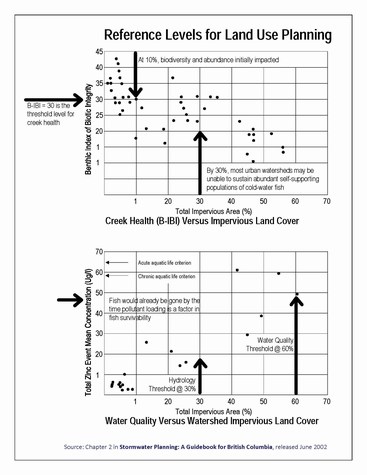A Science-Based Road Map for Integrated Rainwater Management
Factors Limiting Stream Health
In the 1990s, the Center for Urban Water Resources Management at the University of Washington conducted and desseminated the seminal body of work now used internationally by stormwater managers. Many municipalities used this information to update their regulations and management practices.
The catalyst for this research was the salmon crisis in the Pacific Northwest. The salmon is an icon in both Washington State and British Columbia. It is also the early warning system that there is a problem. The salmon crisis was a catalyst for cross-border sharing and learning.
What Matters Most
In 1996, the Center published the landmark findings of Richard Horner and Chris May. Their paper synthesized a decade of research to identify the factors that degrade urban streams and negatively influence aquatic productivity and fish survival. The four factors limiting stream health are, in order-of-priority:
- Changes in Hydrology
- Disturbance and/or Loss of Integrity of the Riparian Corridor
- Degradation and/or Loss of Aquatic Habitat Within the Stream
- Deterioration of Water Quality
When published, this ranking shook conventional stormwater management wisdom in the Pacific Northwest to its foundation. If the goal is protection of aquatic resources, it proved that a water quality driven program would not achieve the goal. The image above illustrates the research findings for changes in hydrology (#1) and deterioration in water quality (#4). To download a PDF copy, click on Reference Levels for Land Use Planning.
A Road Map
Two key messages flowed from this research: salmon would already be gone by the time pollutant loading is a factor in salmon survivability; if we get the hydrology right, water quality typically takes care of itself. The four factors provide a road map for integrated rainwater management.
A science-based understanding of how land development impacts watershed hydrology and the functions of aquatic ecosystems provides a solid basis for making decisions to guide action where it is most needed.
An understanding of the science is a critical underpinning of strategies to predict and manage the impacts of rainwater and stormwater as related to land use change.
Stormwater Planning: A Guidebook for British Columbia
 “The stream health findings by Horner and May gave us a springboard to reinvent urban hydrology. Released by the Province in June 2002, Stormwater Planning: A Guidebook for British Columbia is a transformational document. It quickly became a catalyst to implement a ‘design with nature’ approach to rainwater management and green infrastructure,” states Peter Law.
“The stream health findings by Horner and May gave us a springboard to reinvent urban hydrology. Released by the Province in June 2002, Stormwater Planning: A Guidebook for British Columbia is a transformational document. It quickly became a catalyst to implement a ‘design with nature’ approach to rainwater management and green infrastructure,” states Peter Law.
Formerly with the BC Ministry of Environment, Peter Law chaired the Guidebook Steering Committee. Now retired from government, he is a Director of the Partnership for Water Sustainability in British Columbia.
“In British Columbia, we have built on the foundation provided by the pioneering work of Horner and May and others. They provided us with a science-based understanding of the importance of ‘changes in hydrology’. Their work yielded guiding principles that are standing the test of time.”
Impact of Changes in Hydrology
The image below is reproduced from the Guidebook and is based on the research by Richard Horner and Chris May. It illustrates how the cumulative effects of increasing impervious area in a watershed combined with loss of riparian corridor integrity (as shown in the first two rows), alter the natural Water Balance and impact stream corridor ecology (as shown in the last two rows). To download a PDF copy, click on the image.
This early research established that ~10% impervious cover is a threshold level at which fisheries biodiversity and abundance are initially and significantly impacted. By ~30% impervious cover, most urban watersheds in the Pacific Northwest may be unable to sustain abundant self-supporting populations of cold-water fish.
To Learn More:
To download a copy of Chapter 2 from the Guidebook, click on The Science Behind Integrated Stormwater Management
Posted August 2011



